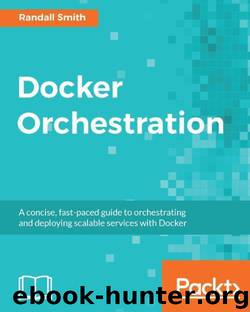Docker Orchestration by Smith Randall

Author:Smith, Randall [Smith, Randall]
Language: eng
Format: azw3
Publisher: Packt Publishing
Published: 2017-01-24T05:00:00+00:00
Rolling back an update
You may find that, after the update, something has gone horribly wrong, and that the update needs to be rolled back. Fortunately, there is a very convenient undo command:
$ kubectl rollout undo deploy/update-deploy deployment "update-deploy" rolled back
Without options, the command will revert the named deployment to the previous one in the history. The --to-revision=N flag will revert the deployment to revision N from the history.
Deleting a deployment
Remember that the job of a deployment is to ensure that the required number of pods are running. Trying to delete a deployment by deleting the pods is like Sisyphus trying to roll a rock up a hill. Kubernetes will keep recreating the pods as fast as they are deleted. When a deployment is no longer needed, it can be deleted with kubectl delete deployment. Make sure that you want to proceed because this will delete all running pods which are part of the deployment:
$ kubectl delete deployment web deployment "web" deleted
It is possible to delete a deployment while leaving the pods running, using the --cascade=false flag. The leftover pods will have to be deleted manually.
Download
This site does not store any files on its server. We only index and link to content provided by other sites. Please contact the content providers to delete copyright contents if any and email us, we'll remove relevant links or contents immediately.
Embedded Programming with Modern C++ Cookbook by Igor Viarheichyk(4145)
Implementing Cellular IoT Solutions for Digital Transformation by Dennis McCain(4057)
Linux Device Driver Development Cookbook by Rodolfo Giometti(4052)
Embedded Linux Development Using Yocto Project - Third Edition by Otavio Salvador & Daiane Angolini(3913)
TinyML Cookbook by Gian Marco Iodice(3816)
Simplifying 3D Printing with OpenSCAD by Colin Dow(2926)
TinyML Cookbook by Gian Marco Iodice & Ronan Naughton(2676)
Fusion 360 for Makers by Lydia Sloan Cline(2337)
Networking A Beginner's Guide by Bruce Hallberg(2319)
Hands-On Linux for Architects by Denis Salamanca(2151)
Computers For Seniors For Dummies by Nancy C. Muir(2127)
But How Do It Know? by J. Clark Scott(2107)
Raspberry Pi and MQTT Essentials by Dhairya Parikh(2071)
Arduino Project Handbook, Volume 2: 25 Simple Electronics Projects for Beginners by Geddes Mark(2030)
9781803246888-ENHANCING DEEP LEARNING WITH BAYESIAN INFERENCE by Unknown(1995)
Hack and HHVM by Owen Yamauchi(1978)
31 Days Before Your CompTIA A+ Exams (Shanette Luellen's Library) by Benjamin Patrick Conry(1944)
Hands-On Internet of Things with MQTT by Tim Pulver(1857)
MicroPython Projects by Jacob Beningo(1854)
